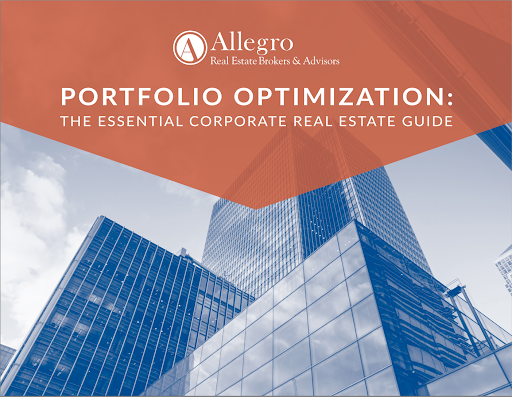For most companies, real estate is the second or third largest item on the balance sheet and P&L statement. The assets in your portfolio impact nearly all aspects of your business, including operational efficiency, talent acquisition and retention, and your ability to achieve financial objectives.
To determine if your commercial real estate strategy supports your overall business strategy, you need to review the assets in your portfolio. When assessing your commercial real estate portfolio, break down assets into three categories:
- Unsupportive assets: Assets that do not support your goals or help you reach your organization’s mission.
- Supportive assets: Assets that add value, and help you achieve organizational goals.
- Missing assets (or gaps): Assets that should be added to your real estate portfolio or modified in order to support your business’ strategy. or existing assets that need to be modified.
Classifying assets into these clear categories enable you to enact strategies to maximize supportive assets, address gaps in your portfolio, and dispose of unsupportive assets. Below, we explain more about each asset type and how you can start segmenting your portfolio.
How to Identify Unsupportive Assets
An unsupportive asset is any real estate that no longer adds value to your organization. It doesn’t meet a number of critical requirements and is a location that no longer supports your goals. In most cases, unsupportive assets offer near-term opportunities to dispose and extract capital that can be strategically redeployed by the organization.
How to deal with unsupportive assets does not always have a clear-cut answer. Unsupportive assets should be dealt with as soon as the organization is reasonably capable. With more complex scenarios, this may require some time and require proper planning.
Here are the most important questions to ask yourself when deciding if an asset is unsupportive:
- Can the asset be repositioned to become supportive to the organization? Through financial or operational changes, it’s very possible to make existing assets truly supportive for the organization. For example, you might redesign an office to accommodate headcount growth or re-engineer your occupancy cost profile. By remedying one or both issues, the asset could quickly add value to your organization again. However, sometimes because of strategy, hurdles are too large to overcome and the asset must be divested.
- If the unsupportive asset is leased, what is the best approach to mitigating the occupancy cost liability? Does the lease have an early termination right with an associated penalty? Can you negotiate a lease buyout with the landlord or, based on market conditions, is it more beneficial to take the space to the market for sublease? Also, what are sublease and assignment rights and restrictions?
- If the unsupportive asset is owned, what is the best approach to divesting? Depending on the unique characteristics of the asset, a series of disposition strategies should be considered. Options include an outright sale, accelerated sale, sealed-bid auction and more. If a portion of the property is supportive but there is surplus property, can you implement a lot split and sell the excess real estate?
- Is the asset in a location where the market has changed? For example, is it a former industrial area that has transitioned to a hip, urban residential neighborhood? Can the property be repositioned to take advantage of the value of this higher use? If the property has been environmentally impaired, what brownfield redevelopment strategies can be employed?
When unsupportive assets are identified, in many cases, they provide a near-term opportunity to create cash flow, reduce operating expenses, and/or mitigate liabilities.
How to Identify Supportive Assets
In direct contrast, a supportive asset is any piece of real estate that adds value to your organization. It doesn’t have to be perfect, but it meets a number of critical requirements and is a location that helps you achieve your organization’s goals.
These are properties where you’ll want to maximize their positive impact to business strategy. Consider optimizing these supportive assets to make the most of them, such as financial restructuring, occupancy cost control, cost segregation or energy management initiatives.
Here are the most important questions to ask yourself when deciding whether an asset is supportive or not:
- Considering the financial strategy of the organization, is the asset financially efficient? Is the cost, equity, or associated liability accretive or dilutive to the organization’s financial goals?
- Is the asset operationally efficient? Does the asset support the work happening within the organization or is the building impeding operational goals for one reason or another? This internal assessment considers the design, layout, utilization, attributes, and size of the location and how each impacts operational efficiency.
- Is the asset strategically efficient? Does the asset support the strategy of the organization upon review of the external environment, competitors, location, supply chain, customers, and/or labor markets?
In a perfect world, the answer to all three groups of questions should be “yes” for a supportive asset. When some or all of the answers are negative, an organization should determine if it is, in fact, an unsupportive asset or presents a “gap” in your real estate portfolio. Having a supportive asset in place will benefit the organization financially, operationally and strategically.
This type of real estate asset has a profound impact on the organization and its people. Once you’ve identified the assets that add value to your company, you’ll want to optimize them to ensure that you are getting the optimal return from each asset.
How to Identify Missing Assets (Gaps)
While identifying your supportive and unsupportive assets, it’s possible you’ll come across specific assets you wish your company had. These are called missing assets or “gaps.” Some examples of missing assets include:
- A new manufacturing facility closer to suppliers that will dramatically reduce transportation time and cost
- A distribution center located closer to customers to decrease delivery costs.
- A new, modern office in the right area for attracting and retaining top industry talent.
To identify gaps in your real estate portfolio, start by asking the following questions:
- Does our real estate give us the best possible access to suppliers?
- Do we need locations that improve our access to customers?
- In terms of location, image or other factors, is there an opportunity to optimize our access to labor markets?
- Is our location holding us back in terms of brand? If so, would it be financially beneficial to find a location that will elevate our image to consumers?
- Do we have proper access to transportation hubs, corridors, and other key infrastructure?
If you identify any gaps in your real estate portfolio through this process, your team should develop an acquisition strategy. An acquisition strategy typically follows the following five phases:
- Project strategy and selection criteria. Identify the essential qualities a new building must have in order to be considered.
- Market research and screening. Pull data from reputable sources, consider researching historical transactions to better understand the local economy and history of the building.
- Decision support. Secure support from leadership at your company. Adopt an open line of communications to ensure your team is on the same page.
- Leveraged negotiations. With your market research in hand and the support of your company’s leadership, approach the negotiation process with a goal in mind. Use the resources you’ve gathered to back up your demands.
- Closing and documentation. Once you’ve reached an agreement, work with your legal department and real estate advisor to properly and efficiently close the deal.
A real estate advisor’s guidance and expertise will be invaluable throughout every step of the acquisition strategy. Advisors use their industry knowledge, connections, and consulting expertise to help companies secure the assets needed to strengthen their portfolio.
Make Your Real Estate Strategy Your Competitive Advantage
Your real estate portfolio is an integral part of your business and operations, which is why ensuring your assets support your mission is crucial.
To learn more about portfolio optimization, download our free guide, Corporate Real Estate Portfolio Strategy: Your Business’ Competitive Advantage.







